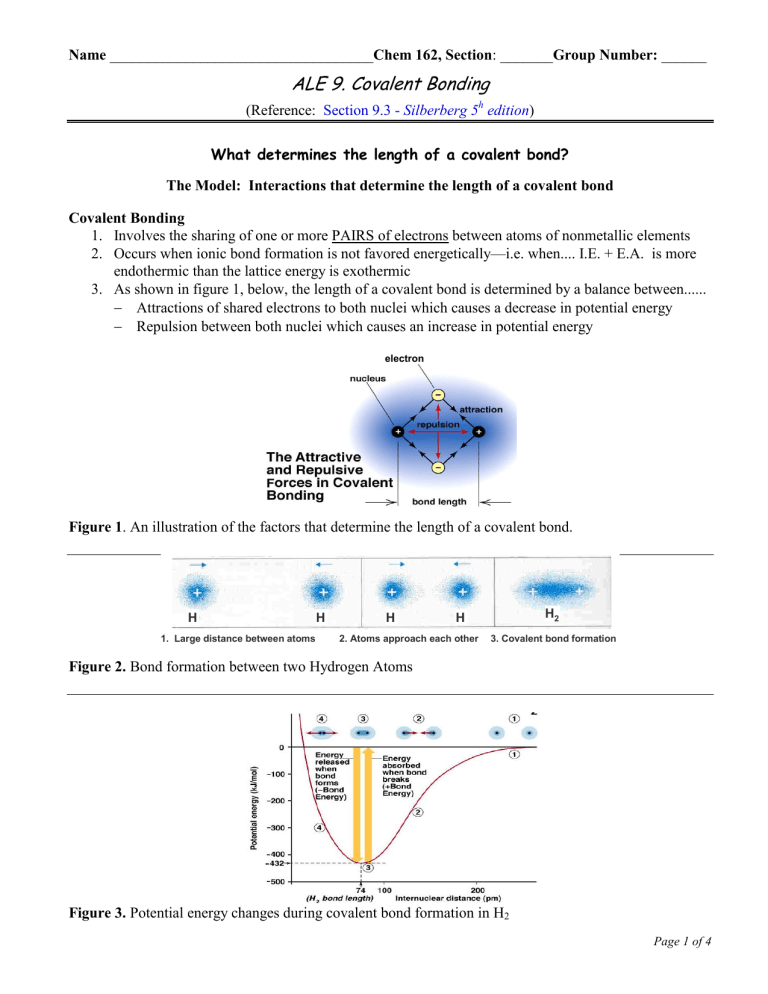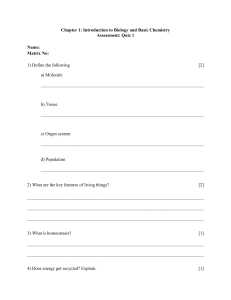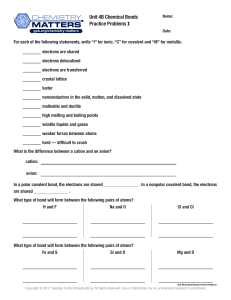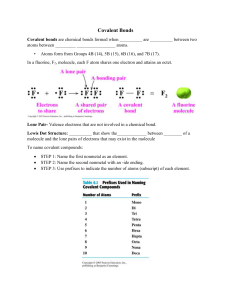
Name ___________________________________Chem 162, Section: _______Group Number: ______ ALE 9. Covalent Bonding (Reference: Section 9.3 - Silberberg 5h edition) What determines the length of a covalent bond? The Model: Interactions that determine the length of a covalent bond Covalent Bonding 1. Involves the sharing of one or more PAIRS of electrons between atoms of nonmetallic elements 2. Occurs when ionic bond formation is not favored energetically—i.e. when.... I.E. + E.A. is more endothermic than the lattice energy is exothermic 3. As shown in figure 1, below, the length of a covalent bond is determined by a balance between...... Attractions of shared electrons to both nuclei which causes a decrease in potential energy Repulsion between both nuclei which causes an increase in potential energy electron Figure 1. An illustration of the factors that determine the length of a covalent bond. Bond formation between two Hydrogen Atoms H 1. Large distance between atoms H H H2 H 2. Atoms approach each other 3. Covalent bond formation Figure 2. Bond formation between two Hydrogen Atoms Figure 3. Potential energy changes during covalent bond formation in H2 Page 1 of 4 ALE 9– Chem 162 – K. Marr (Last Revised Winter 2010) Key Questions 1. Problem 9.34: a.) Describe the interactions that occur between individual chlorine atoms as they approach each other to form chlorine molecules, Cl2. b.) What combination of forces gives rise to the energy holding the atoms together and to the final internuclear distance in all covalent bonds? The Model: Bond length and Covalent Radius for the Halogens (Group VIIA Elements) Exercises 2. Problem 9.36: For single bonds between similar types of atoms, how does the strength of the bond relate to the sizes of atoms involved? Explain. 3. Problem 9.40: Using only the periodic stable as a guide, arrange the members of the following sets in order of increasing bond strength. Be able to explain your reasoning! a.) H—F, H—I, H—Cl b.) C—S, C=O, C—O c.) N—H, N—S, N—O Page 2 of 5 ALE 9– Chem 162 – K. Marr (Last Revised Winter 2010) How can Lewis structures be used to represent covalent bonds in simple molecular compounds? The Model: Lewis Symbols of the Representative Elements The abbreviated orbital diagrams of the 2nd period (“representative”) elements are: Li: [He] ___ ___ ___ ___ 2s 2p Be: [He] ___ ___ ___ ___ 2s 2p B: [He] ___ ___ ___ ___ 2s 2p C: [He] ___ ___ ___ ___ 2s 2p N: [He] ___ ___ ___ ___ 2s 2p O: [He] ___ ___ ___ ___ 2s 2p F: [He] ___ ___ ___ ___ 2s 2p Ne: [He] ___ ___ ___ ___ 2s 2p Below are the Lewis symbols for the above eight representative elements shown above: Key Questions 4. What do the dots represent in Lewis symbols? 5. Why are some of the dots single and others paired up in Lewis symbols? (Hint: think of the s- and psublevels) The Model: Preferred Numbers of Bonds of Representative Elements A covalent bond is the sharing of electrons between two adjacent nuclei. A single bond is the sharing of a pair of electrons. When a covalent bond is formed, heat is released (i.e. the process is exothermic), thus making a system stable. More bonds formed equate to more heat released, thus making the system even more stable. When a Beryllium atom is no longer isolated (i.e., when it is ready to bond), in order to maximize the number of bonds that can be formed (and, therefore, release the most heat into the environment), the Lewis symbol Page 3 of 5 ALE 9– Chem 162 – K. Marr (Last Revised Winter 2010) changes to: Now the Beryllium atom would be able to form two single bonds by sharing electrons with two different atoms. The Lewis symbol of ready-to-bond Boron is shown to the right. Now the Boron atom would be able to form three single bonds by sharing electrons with three different atoms. Key Questions 6. Draw “ready-to-bond” dot symbols for Carbon, Nitrogen, Oxygen, Fluorine, and Neon. 7. What is the preferred number of single covalent bonds that each element in period 2 will form? a.) Li b.) Be c.) B d.) C e.) N f.) O g.) F h.) Ne The Model: Putting Lewis Dot Structures of Atoms Together When two Hydrogen atoms get near each other, they will attract each other’s electron. When each hydrogen atom “sees” the other Hydrogen atom, they “say”, “If I have his electron, I’ll have two, giving me an electron configuration of 1s2, which gives me a noble gas electron configuration!” The two atoms covalently bond with each other, sharing the pair of electrons so that they both resemble a noble gas (Helium). Key Questions 8. What is the incentive for two nonmetallic atoms to share electrons to form one or more covalent bonds? 9. In the symbol: H—H, what does the line segment between the two H’s represent? Page 4 of 5 ALE 9– Chem 162 – K. Marr (Last Revised Winter 2010) The Model: Bonding Pairs vs. Lone Pairs The symbols for ready-to-bond Nitrogen and Hydrogen are: Nitrogen prefers to form three covalent bonds and Hydrogen can only ever form one single bond. So it works out perfectly for a central Nitrogen atom to be surrounded by three Hydrogen atoms: Key Questions 10a. How is a lone pair similar to a covalent single bond? b. How does a lone pair differ from a single bond? 11a. How many electrons are around the central Nitrogen atom in the Lewis structure of NH3? b. What element would a free Nitrogen atom resemble with this number of electrons? Exercises: Draw Lewis structures for each of the following. Include all lone pairs and each covalent bond as a line between the bonding atoms 12. CH4 15. NF3 13. H2O (Hint: oxygen is the central atom) 16. NH4+ (Hint: one of the H atoms lost an electron!) 14. CCl4 17. PH3 Page 5 of 5






